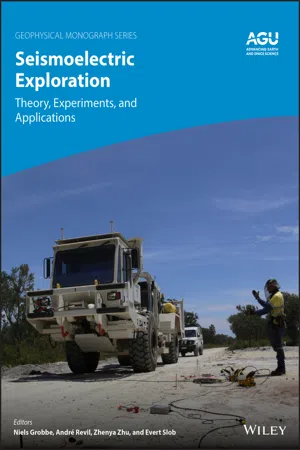
Seismoelectric Exploration
Theory, Experiments, and Applications
- English
- ePUB (mobile friendly)
- Available on iOS & Android
Seismoelectric Exploration
Theory, Experiments, and Applications
About this book
Seismoelectric coupling and its current and?potential future applications
The seismoelectric method—the naturally-occurring?coupling of seismic waves to electromagnetic fields—can provide insight into important properties of porous media. With a variety of potential environmental and engineering uses, as well as larger scale applications such as earthquake detection and oil and gas exploration, it offers a number of advantages over conventional geoEdit HTML Sourcephysical methods.
Seismoelectric Exploration: Theory, Experiments, and Applications explores the coupling between poroelastic and electromagnetic disturbances, discussing laboratory experiments, numerical?modeling techniques, recent theoretical developments, and field studies.?
Volume highlights include:
- Physics of the seismoelectric effect at the microscale
- Governing equations describing coupled seismo-electromagnetic fields
- Examples of successful seismoelectric field experiments in different geological settings
- Current and potential applications of seismoelectric coupling
- Noise removal techniques for seismoelectric field measurements
The American Geophysical Union promotes discovery in Earth and space science for the benefit of humanity. Its publications disseminate scientific knowledge and provide resources for researchers, students, and professionals.
Frequently asked questions
- Essential is ideal for learners and professionals who enjoy exploring a wide range of subjects. Access the Essential Library with 800,000+ trusted titles and best-sellers across business, personal growth, and the humanities. Includes unlimited reading time and Standard Read Aloud voice.
- Complete: Perfect for advanced learners and researchers needing full, unrestricted access. Unlock 1.4M+ books across hundreds of subjects, including academic and specialized titles. The Complete Plan also includes advanced features like Premium Read Aloud and Research Assistant.
Please note we cannot support devices running on iOS 13 and Android 7 or earlier. Learn more about using the app.
Information
FOREWORD 1

Berkeley National Lab
Berkeley, CA, USA
30 July, 2019
FOREWORD 2

PREFACE
Table of contents
- Cover
- Table of Contents
- Title Page
- Copyright Page
- LIST OF CONTRIBUTORS
- FOREWORD 1
- FOREWORD 2
- PREFACE
- Part I: Theory
- Part II: Laboratory Experiments
- Part III: Numerical Modeling
- Part IV: Field Experiments and Applications
- NOMENCLATURE
- INDEX
- End User License Agreement